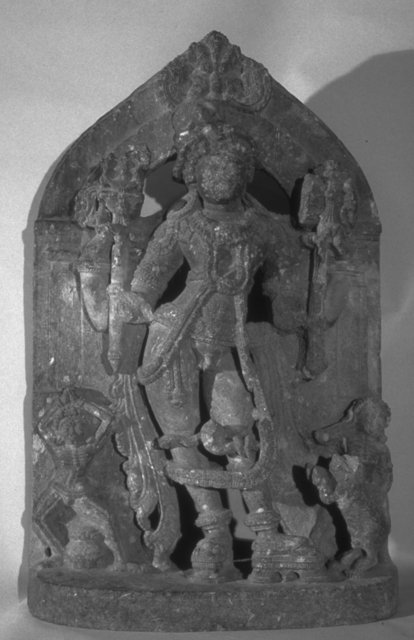An Important Hoysala Dynasty Sculpture of Shiva at the Museum of Art
Skip other details (including permanent urls, DOI, citation information)
: This work is protected by copyright and may be linked to without seeking permission. Permission must be received for subsequent distribution in print or electronically. Please contact [email protected] for more information.
For more information, read Michigan Publishing's access and usage policy.

Hinduism, like many other religions, embraces the concept of asceticism—including the contemplation of death—as a path to spiritual perfection. The archetypal Hindu ascetic is Shiva, one of the most enduring and widely worshipped deities in India and Southeast Asia. In this role, Shiva eschews clothing, human company, and all physical comfort, covering his body with ashes and meditating among corpses or in cremation grounds. His uncut hair grows into long, matted locks, and he may carry a small hand drum to warn others of his approach—all features seen in this image.
This extraordinary sculpture represents Bhairava, or Shiva as the primordial ascetic in his terrifying form. The god stands between two columns in a shrinelike niche surmounted by a kirtimukha, an apotropaic mask. He is heavily bejeweled, with a sash that falls to both sides and a cobra draped over his body. He originally had four arms, of which two are now broken. In his upper right hand, he carries a trident, Shiva’s traditional weapon; and in his upper left hand he carries a damaru, an ascetic’s drum. At his feet, two skeletal figures dance: these are “hungry ghosts,” inhabitants of a purgatory-like realm of existence.
This image adds a particular narrative twist to Shiva’s identity as ascetic: as I have suggested elsewhere (Del Bontà 1981), this iconographical type should be titled Brahmasiraschhedakamurti, or “Shiva as severer of the [fifth] head of Brahma.” There are many versions of the underlying tale, but they all conclude with Shiva slicing off one of the heads of Brahma, the creator god of Hinduism. In Hindu society, murder of a member of the Brahman caste was the most heinous crime; in expiation, Shiva was condemned to wander for twelve years while Brahma’s head remained stuck to his hand at all times. Here the Shiva figure’s two broken arms would have held a sword on the right and a kapala, or skull cup, and the head of Brahma on the left. All that remains is the torso of a dog, leaping up to lick the blood dripping from the now missing severed head of Brahma.
On stylistic grounds this image can clearly be identified as belonging to the period when the Hoysala Dynasty ruled in Karnataka in south central India. The Hoysala style is one of the most ornate in India, and its sculpture is noted for being heavily encrusted with jewels. Since the ascetic Bhairava is nude, one would expect a much simpler treatment, but here he wears three distinctive necklaces, with shoulder pendants, heavy earrings, armlets, bracelets, and even a band just under his breasts. His matted locks are arranged into an elaborate coiffure. These decorative embellishments are hallmarks of the Hoysala style.
Images of Brahmasiraschhedakamurti are quite rare in Indian art, but the type flourished in Hoysala territory, sweeping northeastward through Andhra Pradesh into Orissa during the twelfth and thirteenth centuries, probably as the primary cult image of the Kapalikas, a tantric Shiva sect. A related iconography is found at Khajuraho in Madhya Pradesh, a site with known Kapalika connections. The Kapalikas were known for taking an oath that compelled them to reenact Shiva’s penance for Brahmicide, wandering as ascetics for twelve years. In other regions of India, Bhairava is often depicted as a demonic figure, but in Hoysala sculpture, as exemplified in the present work, he is usually quite beautiful, with a contemplative expression, a fleshy but athletic figure, and a relaxed yet sensual posture. The Hoysala style celebrates Shiva as a wandering ascetic, de-emphasizing his murderous act. Elsewhere, particularly farther south in Tamilnad, two distinct iconographies developed to portray the different aspects of Shiva’s Brahmicide—one of the terrifying Shiva and another as ascetic wanderer.
Work Cited
Del Bontà, R. J. 1981. “Brahmasiraschhedakamurti, Brahmahatya, and Ritualistic Suicide in Medieval Karnataka.” In Chhavi-2: The Rai Krishnadas Felicitation Volume, 119–122. Banaras: Bharat Kala Bhavan.

